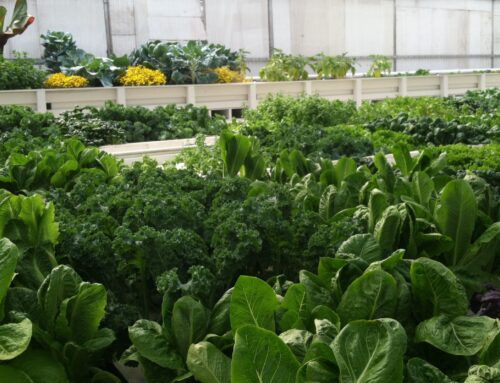The good news – fish waste broken down by bacteria is a surprisingly complete plant fertilizer. However, aquaponic systems are routinely deficient in a few nutrients – primarily potassium, calcium, and iron. We routinely address the potassium and calcium deficiencies by buffering (raising) our system’s pH with compounds based on those elements. But what should one do about iron?
First, you need to determine whether you actually have an iron deficiency. Depending on the type of plants you are growing, the quality of the feed you are feeding your fish, and the quality of your water, you may never have an iron issue. So how do you know? There are really two ways. The first is a visual test. If the leaves on some of your plants are starting to yellow, but the veins in those leaves remain green, your plants probably have “chlorosis”, a condition caused by insufficient iron. But what if you want to spot the problem before your plants show these signs? You can by using an Iron Checker by Hanna Instruments. With this handy little device, you will quickly and easily be able to read the amount of iron in your water in ppm (parts per million). When you take your reading, remember that your target range should be 2 – 3 ppm. When you get to about 1.5 ppm, you will start seeing those yellowing leaves indicating an iron deficiency.
So now that you’ve determined that you need to add iron, how do you do it? Can you just add a rusty nail into your fish tank? Well, no. The rust is iron oxide, which actually isn’t readily available to plants. Plants are particular about the actual form of iron they accept. If it is the wrong form, they cannot take it up and make use of it. One of the forms that works well is called chelation. With chelation, plants naturally release compounds called siderophores into the soil which bind iron and enhance its solubility. Chelation also occurs in mature aquaponic grow beds, but if you need to correct an iron deficiency through a quick hit of iron you need to supply your own chelated iron.
There are different forms of chelated iron, each known by the agent used to perform the chelation. The most common are Fe-EDTA, Fe-DTPA, and Fe-EDDHA. Fe-EDTA is the most common, and can be found in many garden centers. The problem with Fe-EDTA is that it is only 100% effective at a pH of 6.5 or lower. Fe-EDTA rapidly loses its effectiveness as your system pH increases above 6.5. While this may be okay for hydroponic systems that tend to operate at or below pH levels of 6.5, in aquaponic systems aiming for a pH of 6.8 to 7.0, this can be a problem.
Fe-EDDHA, in contrast, is fully effective up to and even above pH 8. The problem is that quality Fe-EDDHA is expensive and it turns your water as red as cherry Kool-Aid. It took weeks to get that awful pink hue out of our fish tanks when we were testing!
In contrast Fe-DTPA is fully effective all the way up to a pH of 7.5 and it is just slightly more expensive than Fe-EDTA. This is why Dr. Rakcocy, and other experts recommend Fe-DTPA for aquaponics. And this is why we have switched to using Fe-DTPA in our AquaIron products.
So how much iron do you add to your aquaponic system? Dr. Rakocy while at the University of the Virgin Islands (UVI) created a standard dosing of 2 mg/liter of water (7.58 mg / gal) of pure iron every 3 weeks. Given that, you need to look at the percent of iron in the particular product you are using. Our AquaIron product is 10% iron, so you would add 7.58 / .1 = approximately 76 mg of AquaIron per gallon, or 7.6 grams / 100 gallons of water every three weeks. Since most of us don’t typically measure in gram weight, we’ve calculated the volume of this as about 1 ½ teaspoons (1/2 of a tablespoon) per 100 gallons of water every 3 weeks. Please note that this measure is specific to our DTPA AquaIron product. We’ve found dramatic differences in the volume / unit of weight among chelated iron products.
Here is the problem with just going with this standard dosing. The amount of iron that your system needs is about 2 ppm. How much you need to add to get there depends on several factors, including the amount of iron already present in your water (if you use well water, for example, you might have iron already present), the amount of iron in your fish feed, and the iron needs of the plants you are growing (how much is being removed from the system by the plants). So, consider getting an Iron Checker and actually test your system iron levels to make sure that you aren’t adding too much, or too little, to get to that sweet spot of 2 – 3 ppm.
Reference paper, see bottom of page two: http://uvi.edu/files/documents/Research_and_Public_Service/AES/Aquaculture/Tilapia_and_Basil.pdf

